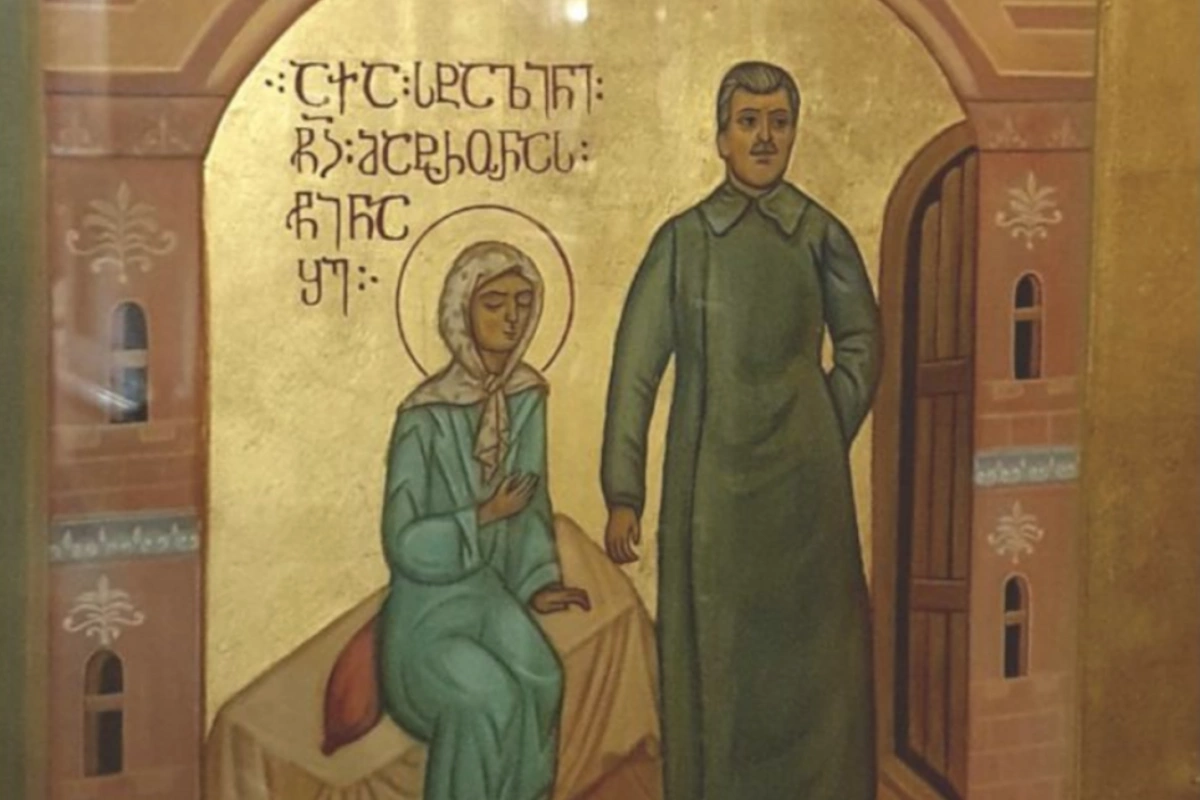
The Soviet dictator "appeared" in Georgia's main church on Christmas, causing sound and fury.
Image: Giorgi Kandelaki video/FB
(Eurasianet) While Georgia was looking the other way, its most famous son, Joseph Stalin, or rather his image, sneaked into the nation's main church, the Holy Trinity Cathedral in Tbilisi, and claimed a spot next to Christian saints.
The icon featuring an image of the Soviet dictator was noticed by the public on Christmas, which is celebrated in Georgia on January 7, and a national uproar followed. "What an insult and a mockery," said popular playwright and commentator Lasha Bughadze. "Behind this image are hundreds of thousands of martyred Georgians and millions of deaths."
In its defense, the Georgian Orthodox Church specified that the debated icon primarily represents St. Matrona of Moscow, a 20th-century Russian saint purported to have the gift of spiritual vision and healing. Stalin is depicted in the painting only to represent an episode in Matrona's life, the Church said. Legend has it that the USSR's leader sought Matrona's advice during World War II.
"If, say, a St. George icon includes a depiction of [Roman emperor] Diocletian, this does mean that this icon is devoted to Diocletian," Church spokesman Andria Jaghmaidze told Tabula Magazine. Some believers also pointed out that it is common in iconography to depict negative characters, including demons and monsters.
But Stalin is not represented in a negative light in the controversial icon, critics argued. "Iconographic depictions of Diocletian, Satan or Dragons follow concrete rules. They are always depicted as fallen, defeated by the good," Doctor of Theology Amiran Gamrekelashvili told the Netgazeti news website. "Stalin, by contrast, is represented in a positive light. Nobody is piercing him with a spear or defeating him. To the contrary, he stands tall and large, and behind him is a smaller figure of Matrona."
Still, the Church stuck to its guns and so did the Patriots Alliance, the political group that donated the controversial icon to the Church. "Stalin is represented with his back to the Church, full of hubris, but in a moment when he is visiting in the saint, which can only mean that God stands above any godless political power," said Irma Inashvili, the leader of Patriots Alliance, which advocates for friendly ties between Georgia and Russia.
"The name of this icon is 'St. Matrona is Blessing Stalin,' this is literally what this image is called," countered Giorgi Kandelaki, a researcher with SovLab, a group researching Georgia's Soviet past. He said that the image and the legend attached to it are meant to glorify the architect of the Great Terror.
"The legend was invented to portray Stalin as a fan of the Church. In reality, during his rule hundreds of priests were tortured and executed in Georgia alone [….] and approximately 80,000 clerics were executed across the Soviet Union," Kandelaki said.
While the nation argued about the posture and the facial expression of the dictator, one woman walked into the Holy Trinity Cathedral on January 9 and threw paint at the controversial image. Nata Peradze, a prominent environmental activist, became an instant hero for Georgian liberals, but a target of attacks and threats from ultraconservatives and the faithful.
Later in the day, she was questioned by police and is facing charges of vandalism, but the charges may be the least of her problems. The following day, the epicenter of tension moved to Peradze's home in Tbilisi. Alt Info, a violence-prone hate group, showed up at her home, seeking revenge for what they saw as a desecration of the church. "Alt Info came to beat me up," said Peradze in a Facebook live, as she filmed a massive police force trying to prevent the mob from approaching her home.
The incident with Stalin represents deep and complex issues Georgia has in the way it sees its past and envisions its future. The nation remains divided about the legacy of the Soviet dictator. To some, he is a mass murderer and Adolf Hitler's Soviet equal, to others he is the defeater of Nazism and the builder of a great empire.
For all the atrocities of his era, some literally pray to Stalin and his imagery can still be found across Georgia. Some marginal groups painted him on icons before, but the ongoing scandal marks the first instance in modern history when Stalin's image appeared in the Holy Trinity Cathedral, Georgia's equivalent of St. Peter's or Canterbury Cathedral.
Critics charge that Stalin's image is meant to whitewash history and strengthen the broken bond between Georgia and Russia. While divided by wars and Russia's occupation of Georgian territories, some Georgians and Russians still bond via nostalgia for the Soviet Union.
Faith is another thing that Georgians and Russians share. Liberal Georgians believe that the Kremlin is using both Soviet nostalgia and Orthodox faith as soft-power mechanisms for influence-peddling in Georgia. The Church is often accused of serving as a witting or unwitting conduit for channeling this influence.
Dismissing such accusations, the Georgian Orthodox Church claims that it is under attack from liberals. In his comments, the Church spokesperson argued that the whole scandal was deliberately started to disrupt Christmas celebrations.
The paint was later scrubbed off the controversial image and the icon was moved to a more prominent position inside the Holy Trinity Cathedral.
Share on social media
The Soviet dictator "appeared" in Georgia's main church on Christmas, causing sound and fury.